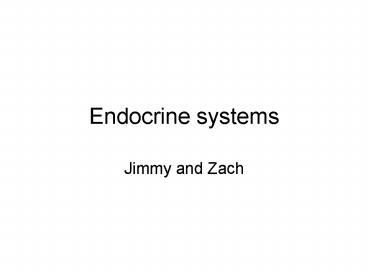Endocrine systems - PowerPoint PPT Presentation
1 / 13
Title:
Endocrine systems
Description:
Melatonin modulates circadian rhythm. Stimulated by darkness and inhibited by light. ... Controls hunger, thirst, and circadian cycles. Thyroid gland. Located ... – PowerPoint PPT presentation
Number of Views:19
Avg rating:3.0/5.0
Title: Endocrine systems
1
Endocrine systems
- Jimmy and Zach
2
Major endocrine parts
- Endocrine system controls the release of hormones
which regulates metabolism, growth and
development, tissue function and mood.
3
Pineal gland
- Near the center of the Brain
- Secretes Melatonin
- Melatonin modulates circadian rhythm.
- Stimulated by darkness and inhibited by light.
- Affects reproduction by depressing gonad activity.
4
Pituitary Gland
- Pea size organ located in the brain.
- Secretes hormones that regulate homeostasis
- Releases hormones that stimulate other endocrine
glands. - Controls growth, blood pressure, pregnancy,
breast milk, sexual organs, thyroid gland,
metabolism and osmoregulation.
5
Hypothalamus
- Linked to the nervous and endocrine system by the
pituitary gland. - Found in all mammalian brains.
- Regulates metabolic and other autonomic
functions. - Synthesizes and secretes neurohormones, which can
stimulate or inhibit pituitary hormones. - Controls hunger, thirst, and circadian cycles.
6
Thyroid gland
- Located in the neck.
- Affects energy use, protein synthesis and hormone
sensitivity. - Controlled by the hypothalamus and pituitary.
7
Thymus
- Located in the upper anterior portion of chest.
- Produces hormones that stimulate production of
infection fighting cells. - Central importance to the maturation of T-cells.
- T-cells mature from thymocytes in the Thymus.
8
Adrenal gland
- Triangular shaped gland sit on top of kidneys.
- Major contributor to stress response.
- Takes part in the fight or flight response.
- Synthesizes cortico-steroids.
9
Pancreas
- Dual role in digestion and endocrine system.
- Produces insulin, glucogon and somatostatin.
- Insulin and glucogon are essential in maintaining
blood sugar levels. High sugar levels release
insulin and low levels release glucogon.
10
Testes
- Produce sperm.
- Primarily secrete androgens such as testosterone.
- Secretion of sex hormones controlled by pituitary
gland.
11
Ovaries
- Produce eggs.
- Make estrogen and progesterone dependent on where
the woman is on in her cycle. - Controlled by the pituitary gland.
12
Human ovary
Gonadotropins FSH (follicle stimulating
hormone) and LH (luteininzing hormone) are
produced during FOLLICULAR PHASE of menstrual
cycle. FSH and LH promote follicular development
and production of estrogen and progesterone
within the developing follicle (not released
until ovulation). At ovulation a pulse of
estrogen and progesterone will provide negative
feedback to hypothalamus to stop FSH and LH
production stop further ovulation. Ruptured
follicle produces corpus luteum to generate more
estrogen and progesterone. This will 1)
continue to inhibit LH and FSH production
2) prepare
uterus lining (endometrium) for arrival of
fertilized egg.
This begins LUTEAL PHASE of menstrual cycle.
Marieb
13
At beginning of LUTEAL PHASE oocyte enters
fallopian tube. Corpus luteum will
secrete estrogen and progesterone for about 12
days. These hormones cause the endometrium to
thicken and prepare for implantation of
fertilized embryo. If implantation occurs the
embryo will produce chorionic gonadotropin which
will establish a positive feedback loop with
corpus luteum. Each maintains the other.
If implantation is successful, placenta will take
over from corpus luteum the job of producing
estrogen and progesterone.
If implantation does not occur, corpus luteum
shuts down, endometrium is not maintained but
shed with unfertilized egg (menstruation). Since
progesterone and estrogen are no longer produced,
cycle returns to follicular phase.
Marieb































